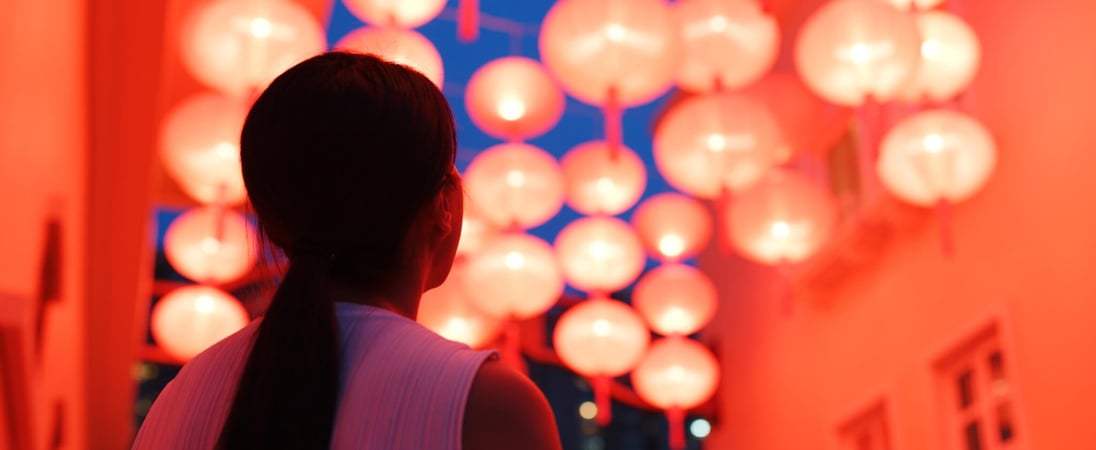
Mid-Autumn Festival
During this enchanting celebration, families gather under the moonlit sky to relish delightful treats, share laughter, and celebrate unity and abundance.
Also known as the Chinese Moon Festival or the Mooncake Festival, the Mid-Autumn Festival is a celebration of the harvest that is an important part of the culture, on par with Chinese New Year. This annual event offers opportunities for families and friends to get together and enjoy one another’s company while they show appreciation for the moon and the harvest that comes in the autumn of each year.
History of Chinese Mid-Autumn Festival
The Mid-Autumn Festival has roots that can be traced back from 2000 to 3000 years. Some historians believe that the first of these festivals was celebrated sometime during the Zhou dynasty (1025-221 BC) when emperors would pray to the gods for good weather and a profitable harvest as well as peace for their country.
Developing during the Tang dynasty (618-907 AD), the Mid-Autumn Festival is associated with different myths and legends centering around Chang-E (the Moon Goddess) and her husband, Hou Yi. One of these stories includes the idea that Hou Yi lived on the sun but he could visit his wife during the full moon, on the 15th day of every month.
By the time China was liberated in the 14th century, the celebration of the Mid-Autumn Festival also became associated with mooncakes. These desserts were rumored to have held secret messages that encouraged rebels to gather together during the Mid-Autumn Festival to join together in revolt against the government. Although the details of the story vary, the tradition of sharing mooncakes during the festival has lived on!
The Mid Autumn Festival is celebrated over three days with many different traditions, events, festivities, parades and food. The date of the festival changes each year as it is set based on the Chinese lunisolar calendar. Specifically, the beginning of the festival falls on the fifteenth day of the eighth lunar month of this calendar, when a full moon is always present. In the Gregorian calendar, this festival falls somewhere between the middle of September and the beginning of October.
In 2008, Mid-Autumn Festival was declared an official holiday, offering adults and children a two-day public holiday from work or from school. The events surrounding the Mid-Autumn Festival typically include an element of reunion, where families gather in the evening to enjoy special dinners, eat mooncakes, light paper lanterns and, for some, pay respects to the moon.
Besides China, many other countries in Asia also celebrate a similar harvest festival during this time, although the names will vary slightly based on the place. For instance, in Japan, the festival is referred to as Tsukimi, while those in Vietnam call it Tết Trung Thu.
Mid-Autumn Festival Timeline
1025-221 BC
Mid-Autumn Festival originates
During the Zhou dynasty, this Chinese festival begins when ancient Chinese emperors take it as a time to worship the autumn harvest moon. [1]
618-907 AD
Myths about the Moon Lady begin
Storytellers during the Tang dynasty develop myths and tales that are eventually associated with the Mid-Autumn Festival or Chinese Moon Festival. [2]
960-1279
Mid-Autumn Festival is deeply established
During the Song dynasty, this festival becomes an established part of Chinese culture with larger celebrations and additional traditions. [3]
1368
Mooncake Uprising takes place during Mid-Autumn Festival
Legend has it that mooncakes are used to send secret messages to gather people for an uprising during the Mid-Autumn festival.[4]
2008
Mid-Autumn Festival made official in China
After being celebrated for centuries, this cultural tradition finally gets its official status as a holiday in China in the early 21st century.[5]
How to Celebrate Chinese Mid-Autumn Festival
Considering some ways it might be fun to incorporate plans for celebrating the Chinese Mid-Autumn Festival? Check out some of these ideas for enjoying the observing the event:
Celebrate with a Family Reunion
One of the most important factors of the Mid-Autumn Festival is the symbolism of the moon related to the idea of reunion. This means that an ideal way to celebrate this event is to gather around with family, friends and other loved ones – particularly those who live far away and have not been together recently – to reunite over a meal. Share stories of what has been happening in life, spend time together and show appreciation for one another.
Those who are not able to be together near the time of the Chinese Moon Festival can celebrate by sending messages with well wishes to friends and family who are far away. Cards and hand written letters are particularly rare in today’s world, but so enjoyable to receive!
Appreciate the Moon
A very important aspect of the Mid-Autumn Festival celebrations is to enjoy, celebrate and show appreciation for the moon. Every day and night, the moon reigns over the sky even when it can’t be seen. This celestial orb is responsible for a wide range of things that make Earth a place where humans can live. The moon is a stabilizing force that helps the planet keep its tilt. In addition, the moon controls the tide as well as the seasons. The moon also affects the circadian rhythms that are important in the life cycles of many animals.
Consider some of these amazing fun facts about the moon to share in celebration of the festival:
- The moon started about ten times closer to the earth than it is now, so it used to look much bigger.
- The moon has a lot of dust and it seems somewhat like gunpowder.
- The surface of the moon experiences wide temperature ranges, from freezing cold on the dark side to boiling on the sunny side.
Enjoy Eating Mooncakes
Because of the association of mooncakes with the Chinese Mid-Autumn Festival, it’s certainly a great idea to enjoy some of these delicious treats in celebration of the event. Those who have access to an Asian bakery nearby may want to place an order in advance to be sure some are available for the celebration.
Other folks might want to try a hand at making mooncakes in honor of the day. Those who search an online recipe will find that ingredients include basic items such as egg yolks (traditional recipes use duck eggs), green tea and golden syrup or honey, as well as other rarer items like dried lotus seeds and lye water. Other ingredients may include creative fillings such as sweet potato, red bean paste, cream cheese, custard and many different varieties.
Give Mid-Autumn Festival Gifts
Some friends, family members, coworkers and others may choose to celebrate the Mid-Autumn Festival season by offering gifts of appreciation. These might include small tokens or larger presents, with traditional ideas such as gifting mooncakes, dried teas, or fruit baskets that represent the theme of harvest. Some people like to give osmanthus wine, or cassia wine, as a gift in celebration of the Mid Autumn Festival because this sweetened wine is often enjoyed when paired with the traditional mooncakes.
Mid-Autumn Festival FAQs
How long is the Mid-Autumn Festival?
In the mainland of China, the Mid-Autumn Festival is celebrated for three days. [1]
Does Korea celebrate Mid-Autumn Festival?
In Korea, the Mid-Autumn Festival is known as Chuseok. [2]
Is Mid-Autumn Festival religious?
This festival is a religious and cultural event when ancient Chinese emperors used to pray for the harvest, good weather and peace for the country.
Why is Mid-Autumn Festival important?
With the moon as the symbol of the Mid-Autumn Festival, this event is one that is centered around the idea of reunion. [3]
Where is Mid-Autumn Festival celebrated?
This festival is celebrated in Asian countries such as China, Taiwan, Singapore, Korea, Japan, Cambodia, Vietnam, Malaysia, Thailand and Indonesia. [4]
Also on ...
View all holidaysNational Mad Hatter Day
Celebrate silliness on this day devoted to John Tenniel’s Mad Hatter from Alice and Wonderland by getting weird, hosting an afternoon tea, and enjoying life.
National Do Something Nice Day
Spreading kindness, one small act at a time, brightens hearts, creates connections, and makes the world a happier, more beautiful place.




